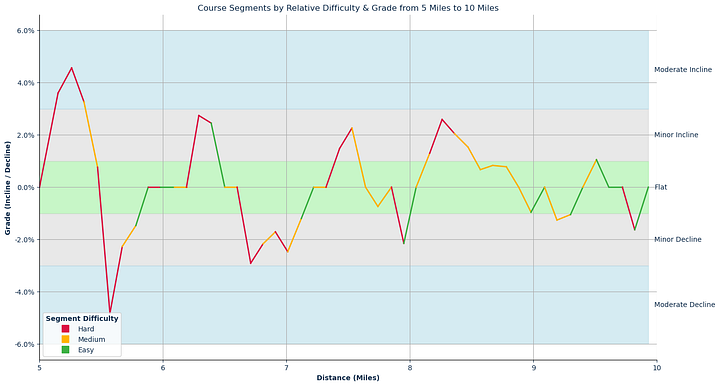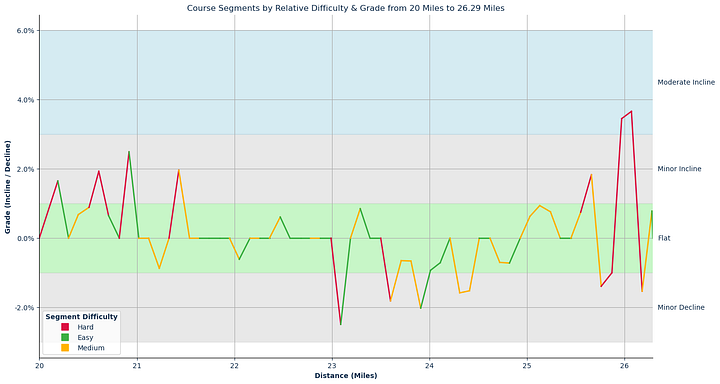Notes: This guide is based on a Run Ready Certified GPX file, created through a standardized process that combines official course maps, measurement certificates, and other plotting techniques. The official course distance is 26.2 m, which is the shortest possible route while staying within the course boundaries. The certified GPX file measures the course at 26.29 m, so distances in the guide are approximate.
This is the Imperial Edition (Miles & Feet) of the course guide. The Metric Edition (Kilometers & Meters) is available here.
See footnote on course elevation.1
Course Overview
The Los Angeles Marathon has become one of the most recognized races in the country, running point to point through some of Los Angeles’s most famous neighborhoods. This year’s race starts at 7:00 a.m.—very close to sunrise—so expect early morning light as you set off from Dodger Stadium.
Expect starting temperatures in the low-to-mid 50s°F with moderate humidity, historically warming into the 60s by midday. While the route does feature a net downhill, there are some short, steeper sections early on (near Mile 0.2 and Mile 4–5) and another notable uphill just before the finish. Stay mindful of these transitions, and focus on sustaining a smooth rhythm through the rolling terrain.
Key Stats
Event Date: March 16, 2025
Event Type: Road Marathon
Course Length: 26.2 miles
Course Type: Point to Point
TrailScore: 37.9
Road Marathon Difficulty Rating: Easy
Total Ascent: 747.61 feet
Total Descent: 998.72 feet
Longest Uphill: Starting at Mile 8.16, 0.73 miles at an average grade of 1.39%
Longest Downhill: Starting at Mile 0.42, 1.03 miles at an average grade of -3.38%
Significant Climbs (≥3% grade & ≥0.1 miles):
Climb #1: Mile 0.21 to 0.31, 0.10 mi, avg grade 3.91%, total gain 21.2 ft
Climb #2: Mile 4.13 to 4.33, 0.20 mi, avg grade 6.91%, total gain 73.7 ft
Climb #3: Mile 4.95 to 5.36, 0.41 mi, avg grade 4.08%, total gain 89.0 ft
Climb #4: Mile 25.87 to 26.07, 0.21 mi, avg grade 3.55%, total gain 38.6 ft
Significant Descents (≤-3% grade & ≥0.1 miles):
Descent #1: Mile 0.31 to 0.52, 0.21 mi, avg grade -5.51%, total drop 60.0 ft
Descent #2: Mile 0.62 to 0.83, 0.21 mi, avg grade -3.36%, total drop 36.5 ft
Descent #3: Mile 1.14 to 1.34, 0.20 mi, avg grade -3.40%, total drop 36.4 ft
Descent #4: Mile 1.76 to 1.96, 0.21 mi, avg grade -4.69%, total drop 50.9 ft
Descent #5: Mile 2.99 to 3.10, 0.10 mi, avg grade -3.13%, total drop 17.3 ft
Descent #6: Mile 4.53 to 4.74, 0.21 mi, avg grade -4.84%, total drop 52.8 ft
Descent #7: Mile 5.47 to 5.57, 0.10 mi, avg grade -4.83%, total drop 26.7 ft
Descent #8: Mile 11.70 to 11.80, 0.10 mi, avg grade -4.45%, total drop 24.4 ft
Descent #9: Mile 13.98 to 14.08, 0.10 mi, avg grade -3.19%, total drop 17.4 ft
Descent #10: Mile 14.29 to 14.39, 0.10 mi, avg grade -3.67%, total drop 19.5 ft
Descent #11: Mile 14.49 to 14.90, 0.41 mi, avg grade -5.86%, total drop 126.3 ft
Descent #12: Mile 18.52 to 18.63, 0.10 mi, avg grade -3.34%, total drop 18.5 ft
Grade Distribution:
Flat: 58.4%
Minor Decline: 16.1%
Minor Incline: 14.1%
Moderate Decline: 6.3%
Moderate Incline: 2.7%
Challenging Decline: 1.6%
Challenging Incline: 0.8%
Course Briefing
Miles 0-5 (Downtown LA Launch)
Overview
You’ll set off near sunrise, moving into a gentle downhill after about the 0.4-mile mark, then passing through the heart of Downtown Los Angeles. Keep an eye out for quick but sharper inclines around Mile 0.2 and between Mile 4 and 5. This first stretch can feel fast—especially with the race-day excitement—but try to settle into a balanced effort, avoiding burnout on the early climbs.


Key Challenges
Early Short Climb: The incline from Mile 0.2 to 0.3 can come as a surprise; maintain even effort and good form.
Steep Spur After Mile 4: A sharper climb (about a 6.9% grade) occurs near Mile 4.5. Stay relaxed and focus on controlled breathing.
Aid Stations
Mile 2.25: Electrolit & Water
Mile 3.15: Electrolit & Water
Mile 4.67: Electrolit & Water
Points of Interest
Chinatown Gateway Monument (near Mile 1.8): A symbol of LA’s multicultural heritage.
Los Angeles City Hall (near Mile 2.9): An iconic building featured in many films and TV shows.
Bradbury Building & Grand Central Market (near Mile 3.8–4.0): Historic spots offering a glimpse of classic LA architecture and food culture.
On Course Entertainment
Mile 1: East Wind Lion Dancers
Mile 4: Koshin Taiko Drummers
Miles 5-10 (Climbing Through Hollywood)
Overview
Around Mile 5 to 6, you’ll face more noticeable inclines, including the climb starting near Mile 4.95 (around a 4% grade). Once you crest these, the terrain remains somewhat rolling as you approach Hollywood. Conserve energy on the ascents and use the brief, gentle downhills to recover. By the time you reach Mile 10, you’ll be nearing Hollywood Boulevard.


Key Challenges
Extended Climb Near Mile 5: A 4% grade can sap energy; focus on smooth, efficient form.
Rolling Terrain to Mile 10: These small up-and-down sections can add up if you’re not careful with pacing.
Aid Stations
Mile 5.81: Electrolit & Water
Mile 6.5: Medical
Mile 7.13: Electrolit & Water
Mile 8: Electrolit & Water
Mile 8.73: Medical
Mile 9.01: Electrolit & Water
- **Mile 10.09 (Medical)**
Points of Interest
Old Fire Station #6 (around Mile 5.3): A piece of LA’s architectural history.
Echo Park Lake area (approx. Mile 6–6.2): Known for its scenic waters and cultural vibe.
Sunset Junction (near Mile 7.8–7.9): A hotspot marking the convergence of Sunset Blvd. and Santa Monica Blvd.
Barnsdall Art Park (near Mile 8.8–9.0): Features the UNESCO-listed Hollyhock House.
On Course Entertainment
Mile 6: Sidle Entertainment Drumline
Mile 8: Silverlake Conservatory of Music
Mile 10: Greg Young Trio
Miles 10-15 (Iconic Hollywood & West Hollywood)
Overview
This section takes you through some of LA’s most renowned sights. The route is largely level with brief minor declines and inclines. From Mile 10 to about 13, you’ll be on Hollywood Boulevard near the Walk of Fame. As you transition into West Hollywood, the course stays mostly steady, with a few small rollers leading up to Mile 15.


Key Challenges
Subtle Undulations: Although it appears mostly flat, mild grade changes between Miles 13 and 15 can catch up with tired legs.
Staying Focused Amid Landmarks: Hollywood can be a mental distraction with its crowds and famous sights. Stick to your plan.
Aid Stations
Mile 11.03: Electrolit & Water
Mile 11.92: Medical
Mile 12.03: Gu, Electrolit & Water
Mile 12.44: Electrolit & Water
Mile 13.06: Electrolit & Water
Mile 13.97: Electrolit & Water
Mile 14.98: Electrolit & Water
Points of Interest
Hollywood Walk of Fame (Mile 10–11 range): You might catch the names of iconic stars beneath spectator’s feet.
TCL Chinese Theatre (around Mile 11.6): Famous for celebrity handprints and footprints.
Sunset Strip (around Mile 14.3–14.4): A storied stretch in West Hollywood.
On Course Entertainment
Mile 11: Rose City DJ
Miles 15-20 (Beverly Hills Approach)
Overview
At Mile 15, you’ll head toward Beverly Hills. The terrain alternates between flat roadways and gentle ups and downs. Look out for a few short inclines between Miles 17 and 18, though none are particularly steep. A net descent from around Mile 18 to 19 can provide a boost if your legs are still strong.


Key Challenges
Gradual Inclines Around Mile 17: Manage your effort and stay alert to these rises.
Fighting Fatigue: You’ll be well into the race. Maintain fueling and keep a steady pace.
Aid Stations
Mile 15.95: Electrolit & Water
Mile 17.88: Gu, Electrolit & Water
Mile 17.93: Electrolit & Water
Mile 18.91: Electrolit & Water
Points of Interest
Rodeo Drive (approx. Mile 16.8–17.1): World-famous for high-end shopping and Beverly Hills glamor.
Beverly Hills Shield (around Mile 17.8–18.0): A well-known city sign and popular photo op.
On Course Entertainment
Mile 15: Cheer LA
Mile 17: Pink Mozart
Mile 18: Rose City DJ
Mile 19: LA Taiko Ichiza
Miles 20-26.2 (Brentwood Turnaround to Finish)
Overview
The last 10k guides you toward through the turnaround in Brentwood, and back to Santa Monica Boulevard to the finish near the intersection with Ave of the Stars. Expect gentle rolling sections, with a noticeable uphill around Mile 25.9 to 26.1. Stay controlled on that late climb, then use any slight downhill afterward to fuel your final push toward the finish.


Key Challenges
Late Climb at Mile 25.9: Around a 3.5% grade, it can feel tough on tired legs.
Energy Management: With just over 6 miles to go, mental focus and proper hydration will help carry you through.
Aid Stations
Mile 22.6: Medical
Mile 23.61: Electrolit & Water
Mile 24.83: Electrolit & Water
Mile 25.87: Medical
Points of Interest
Brentwood City Sign (around Mile 21.4–22.8): Marks a scenic, upscale residential area.
Santa Monica Boulevard (final miles): After getting back on this iconic thoroughfare, it leads you to the finish.
On Course Entertainment
Mile 20: Dustland Fairytale (A Killers Cover Band) & Rose City DJ
Mile 21: New West Charter School Band
Mile 24: Rose City DJ
Mile 25: Bake Some Noise & Hawaiian Airlines Serenaders
More 2025 Course Guides
The LA Marathon has an embedded Strava map on their website that states the course has 932 ft of elevation gain. That GPX file contains 653 trackpoints with an average 212.88 ft between points. Our Run Ready Certified GPX file for the course contains 5,252 trackpoints with an average distance of 26.4 ft. Furthermore we apply a smoothing algorithm in order to filter out the noise that comes with sampling that frequently in order to arrive at our measure of 747.61 ft of elevation gain.






